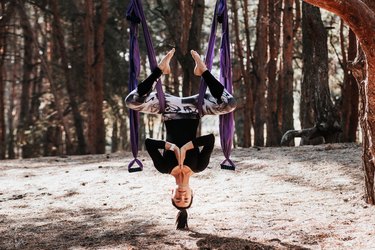
Inversion exercises hang you upside down in an effort to provide relief from lower back pain, improve circulation and better your posture. To hang upside down, use exercise equipment slowly to allow your body time to get used to the uncommon, inverted position.
Video of the Day
Video of the Day
Equipment to Hang Upside Down
According to the Mayo Clinic, inversion therapy, in theory, takes gravitational pressure off your nerve roots and spine disks to increase the space between vertebrae. The Clinic notes that some people find this type of traction helpful as part of a treatment program for lower back pain caused by spinal disk compression.
The main type of equipment to hang upside down is an inversion table, which features adjustable headrests and footrests and handlebars. Used to reduce back pain and decompress your spine from every day stresses and activities, inversion tables bring you gradually from a lying-down position to a vertical position using ankle holders to adjust to different tilting positions.
You can choose whether you want a full or partial inversion and if you'd rather simply hang upside down. You can also perform exercises on the inversion table, such as crunches or upside down squats.
Gravity boots also are used for inversion therapy. Similar in appearance to ski boots, these specialized boots feature a hook or clips that attach to an inversion table, rack or bar to provide additional support. While wearing gravity boots, you can perform abdominal exercises for an extra health benefit, in addition to stretching your back.
Warning About Inversion Therapy
An inversion table should be used with caution, according to a September 2019 study from the Journal of Neurological Sciences. Researchers suggest that an inversion table tilt can cause blood flow health complications when using the equipment as a therapeutic tool or during surgical procedures in patients with previous history of elevated cranial pressure. The researchers therefore note that inversion therapy should be used with caution.
An April 2017 clinical practice guideline from the Annals of Internal Medicine also found that any evidence that traction therapies work (such as inversion therapy) was insufficient and of low quality.
According to the Mayo Clinic, inversion therapy doesn't provide lasting back pain relief, and not everyone should use equipment that hangs you upside down due to risks. The Mayo Clinic suggests you avoid use if you have any of the following:
- High blood pressure — the therapy increases pressure on your circulatory system when you invert for more than a couple of minutes.
- Glaucoma — the intensity of the pressure on your eyes jumps dramatically.
- Heart disease — the therapy slows your heartbeat.
In addition, those who are pregnant shouldn't use equipment that hangs you upside down as this can cause increased pressure on the belly.
Harvard Health Publishing also says you should not try to diagnose your own back pain. You should instead speak with a medical professional to assess your back problem and discuss the possibility of using inversion therapy as part of a comprehensive treatment program.
- Mayo Clinic: “Inversion Therapy: Can It Relieve Back Pain?”
- Annals of Internal Medicine: “Noninvasive Treatments for Acute, Subacute, and Chronic Low Back Pain: A Clinical Practice Guideline From the American College of Physicians”
- Harvard Health Publishing: "Where to Turn for Low Back Pain Relief"
- Journal of Neurological Sciences: "Dynamic Assessment of Cerebral Blood Flow and Intracranial Pressure During Inversion Table Tilt Using Ultrasonography"
Was this article helpful?
150 Characters Max
0/150
Thank you for sharing!
Thank you for your feedback!